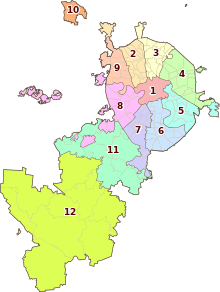Kuntsevo District
| Kuntsevo District Кунцево (Russian) | |
|---|---|
 Location of Kuntsevo District in Moscow | |
| Coordinates: 55°44′N 37°26′E / 55.733°N 37.433°ECoordinates: 55°44′N 37°26′E / 55.733°N 37.433°E | |
.png) |
.png) |
|
| |
| Location | |
| Country | Russia |
| Federal subject | Moscow |
| Statistics | |
| Population (2010 Census) | 142,497 inhabitants[1] |
| • Urban | 100% |
| • Rural | 0% |
| Time zone | MSK (UTC+03:00)[2] |
| Official website | |
| Kuntsevo District on WikiCommons | |
Kuntsevo (Russian: Ку́нцево) is a district in Western Administrative Okrug of the federal city of Moscow, Russia. Population: 142,497 (2010 Census);[1] 125,100 (2002 Census).[3]
History
In the 18th century, a palace and a park were built; they were often visited by the Empress Catherine II. Kuntsevo is the site of the Church of Theotokos Orans. In the 19th century, Kuntsevo became a summer resort for the Muscovites. A summer theater was opened in 1890. Artists and writers lived and worked in Kuntsevo; among them Nikolay Karamzin, Ivan Turgenev, Vasily Perov, and Ivan Kramskoy.
Kuntsevo became a town in its own right in 1926. On December 4, 1941 German troops reached Kuntsevo during the Battle of Moscow before being repulsed. In 1960, it became a part of Moscow. Now a district of Moscow, it contains many factories, residential areas, and has a well-connected infrastructure. Kuntsevo is reported to be the location of the Strategic Missile Command center.[4]
Transport
The district has two metro stations: Molodyozhnaya on the Arbatsko-Pokrovskaya Line and Kuntsevskaya on the Arbatsko-Pokrovskaya and the Filevskaya Line. Strogino metro station in neighboring Strogino District serves parts of the Myakinino area of the Kuntsevo district.
The Myakinino area is also served by bus number 638 that goes from to Shchukinskaya metro station via Strogino. From Rublevo buses:
127 Rublevo - Kotsyubyns'kogo Street (to Molodyozhnaya metro station)
129 Myakinino - Carpool General Staff (to Krylatskoye metro station )
626 3rd district Strogina - Molodyozhnaya metro station
Part of the southern boundary of the district is the Moscow to Smolensk Main Line main railway toward Belarus. Commuter stations on this line connect with the Belorussky railway station in Moscow. Heading west on the mainline, commuter trains go to Golitsyno, Moscow Oblast, Kubinka and Mozhaysk. The branch line to Usovo and the freight-only line to Rublevo leave the mainline in Kuntsevo district at Rabochiy Posolok.
Kuntsevo Dacha

Communist leaders started to settle in Kuntsevo in the 1920s. Joseph Stalin instructed his architect, Miron Merzhanov, to build him a dacha on the bank of the Moskva River and moved there in 1934. With his move other members of the Soviet elite had their dachas built in the surroundings.[5] Stalin conducted much of his business from his Blizhnyaya Dacha (Ближняя дача) ("nearby dacha"). It was heavily protected and included a double-perimeter fence, camouflaged 30-millimeter antiaircraft guns, and a security force of three hundred NKVD special troops.[4] Stalin died at the dacha on March 5, 1953.
See also
References
- 1 2 Russian Federal State Statistics Service (2011). "Всероссийская перепись населения 2010 года. Том 1" [2010 All-Russian Population Census, vol. 1]. Всероссийская перепись населения 2010 года (2010 All-Russia Population Census) (in Russian). Federal State Statistics Service. Retrieved June 29, 2012.
- ↑ Правительство Российской Федерации. Федеральный закон №107-ФЗ от 3 июня 2011 г. «Об исчислении времени», в ред. Федерального закона №271-ФЗ от 03 июля 2016 г. «О внесении изменений в Федеральный закон "Об исчислении времени"». Вступил в силу по истечении шестидесяти дней после дня официального опубликования (6 августа 2011 г.). Опубликован: "Российская газета", №120, 6 июня 2011 г. (Government of the Russian Federation. Federal Law #107-FZ of June 31, 2011 On Calculating Time, as amended by the Federal Law #271-FZ of July 03, 2016 On Amending Federal Law "On Calculating Time". Effective as of after sixty days following the day of the official publication.).
- ↑ Russian Federal State Statistics Service (May 21, 2004). "Численность населения России, субъектов Российской Федерации в составе федеральных округов, районов, городских поселений, сельских населённых пунктов – районных центров и сельских населённых пунктов с населением 3 тысячи и более человек" [Population of Russia, Its Federal Districts, Federal Subjects, Districts, Urban Localities, Rural Localities—Administrative Centers, and Rural Localities with Population of Over 3,000] (XLS). Всероссийская перепись населения 2002 года [All-Russia Population Census of 2002] (in Russian). Retrieved August 9, 2014.
- 1 2 Globalsecurity.org
- ↑ Stephen Lovell. Summerfolk: A History of the Dacha. Cornell University Press (2003),ISBN 0-8014-4071-8. p. 153f. ISBN 978-0-8014-4071-7.
